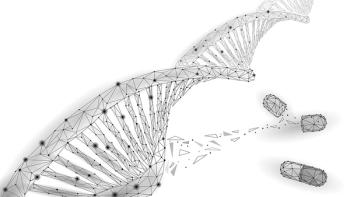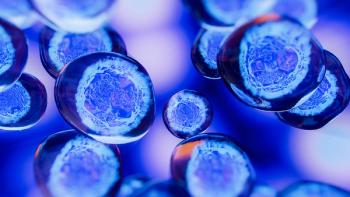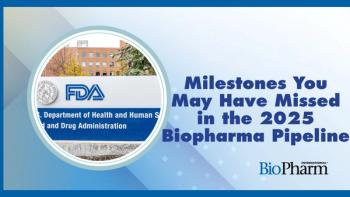
Q&A: An Evolution in Enzyme Engineering with Zymvol’s Marina Cañellas
Key Takeaways
- Enzyme engineering enhances industrial processes by improving efficiency and sustainability through bioinformatics, molecular modeling, and AI integration.
- Enzymes offer advantages over traditional catalysis, including selectivity and eco-friendliness, but their industrial use is limited due to natural enzyme constraints.
Enzyme engineering holds promise, but Marina Cañellas of Zymvol Biomodeling says the enzymes themselves need to be improved through increased discovery and investigation to be able to achieve a greater amount of chemical reactions.
For CPHI Frankfurt 2025, Pharmaceutical Technology® Group spoke with
In this exclusive interview with PharmTech Group, Cañellas talks about the innovations in enzyme engineering that are bringing this process more into the mainstream, and the discovery that is still necessary to expand the field to even wider use.
PharmTech Group: How does enzyme engineering enable sustainable, efficient processes?
Cañellas (Zymvol): Before we start talking about enzyme engineering, I would like to take a step back and talk about enzymes themselves. Every second, thousands of chemical reactions are taking place in our bodies, in animals, etc., in our daily lives. On their own, these reactions are not actually able to be executed; they are way too low to be able to sustain life. But nature has found the greatest solution, which are enzymes. Enzymes are natural catalysts that are able to make reactions faster and more efficient. The exciting part of this is that we can actually take out these enzymes from living organisms or from cells, and we can use them for our own benefit in the industry. This allows us to carry out chemical reactions, not only effectively, but also more sustainably, and it also often allows us to lower the cost of that.
Compared to traditional chemical catalysis, enzymes bring several advantages to the industry. Enzymes, because of their structure, are way more selective than traditional chemistry, and this means that you can lower the downstream processes, because you don't need to remove impurities. You don't need to purify some of your APIs, for example. And they are very eco-friendly, because they are able to work at ambient temperatures and ambient conditions. Sometimes, also, enzymes allow us to perform chemistries that traditional chemistry is not able to perform. So we can go beyond what traditional chemistry is able to do. And that's why enzymes are gaining a lot of traction in all aspects of the industry—in pharma, but also in food and fragments, in chemicals, etc.
However, even with the huge advantages of enzymes, we can see in the industry that only a low proportion of the chemical reactions are made [using] enzymes. I think among the 53 million chemical reactions in the industry, only 1% use enzymes, and this is because natural enzymes have not evolved to be introduced in an industrial environment. Because of that, we need to improve these enzymes, and we need to perform enzyme engineering or enzyme discovery in order to find enzymes that are able to perform a particular chemical reaction or in order to improve those enzymes.
In these terms, for a long time, several experimental techniques have been used for enzyme engineering. For example, we have enzyme discovery, which was awarded the Nobel Prize in Chemistry in 2018 to Frances Arnold. We also have metagenomics in order to discover enzymes to perform certain reactions. And these techniques have been very useful. However, they rely on brute force approaches. Basically, they randomly mutate enzymes or randomly select enzymes in nature in order to find an enzyme that works for your particular application. Of course, what this means is that at the end, you are testing thousands or millions of enzyme candidates in the lab in order to find one that works.
In order to improve that—and since this is not very cost effective, it's very laborious, it basically relies on brute force—we use computational approaches in order to be able to model these enzymes in the computer, and in order to select only those enzyme candidates that actually will work in the industry, in an industrial context. So by using molecular modeling, bioinformatics, AI [artificial intelligence], we are able to restrict the amount of enzyme variants or of enzyme hits that need to be tested in the lab, and this allows us to reduce the costs and the times for enzyme engineering.
How does AI fit into the computational framework?
AI alone is not fixing all the problems. Let me first explain the three pillars that we use, and also how we use AI, and then I can rephrase. In our computational framework, we have bioinformatics, which for us is the map in order to perform enzyme discovery or enzyme evolution. Bioinformatics tells us where nature has already been, what nature has already explored, and what could potentially work. It’s a mapping of what we could do.
Then we have molecular modeling. For us, molecular modeling is basically the driver, so it's the most critical pillar for us. [It is like] what moves a car forward. So let’s say if we have this image of bioinformatics being the map, then molecular modeling is the car. What it does is to [help us] understand at the molecular level, at the atomic level, how an enzyme works: so how a substrate, in particular, binds to the enzyme, how catalysis happens, how or which structural changes could improve performance.
By understanding mechanistically how the enzyme works, we can actually drive and direct how we want to proceed, and what are the modifications that we want to do to the enzyme in order to improve this, and to improve the enzyme or say that an enzyme would work for a particular reaction.
The third pillar for us is AI, artificial intelligence. For us, artificial intelligence is like the GPS. It can process known data, and if we combine insights from molecular modeling, from experiments and with bioinformatics, it can suggest the smartest and fastest way to arrive at a certain improvement, for example. However, as in a GPS, it doesn't drive the car. So we need data, we need molecular modeling, we need bioinformatics along with AI to be able to do that. But AI alone, again, won't fix the issues.
It's an excellent tool if you have abundant data. If you have high-quality data, for example, it's really good. If you want to generate thermostable enzymes, it works really well, it's perfect. However, when it comes to improving the catalytic activity of an enzyme, or other more complicated properties—for example if you want to change, let's say, the cofactor of an enzyme, if you want to improve the pH stability of an enzyme, the optimum pH of an enzyme, then AI alone won't solve your problems. And you need to go to molecular modeling again, try to understand at the atomic level of precision, how an enzyme works in order to propose certain improvements.
And that's exactly what we do. We use the three pillars, mainly molecular modeling as the main pillar, but also of course powered by bioinformatics and AI, in order to make the process faster, smarter, and more efficient.
Can you summarize what you’ve learned from the case studies in your presentation?
What I want to share with these case studies is, again, how it's important to use bioinformatics, molecular modeling, and also AI in order to deliver enzyme engineering in a faster and efficient way. The first case study was related to a client, of course. They wanted to produce 3-hydroxypropionic acid at low pH. In this context, the good part is that the chemistry was really attractive, but the problem that they were having is that natural enzymes were efficient enough in acidic conditions, and also, controlling the pH conditions industrially was really not cost-effective, so they needed to find a solution to that.
So they reached out to us and asked us to find, and to also improve, an enzyme to work at acidic conditions. The first thing that we did was to perform Biomatchmaker, which is our platform that integrates bioinformatics, AI, and molecular modeling, in order to find enzymes able to perform a particular reaction. This reaction can be a non-natural reaction, a reaction that has never been observed in nature. We ran that and found 20 promising enzymes that were delivered to the lab; those were tested, and most of them were active for the particular reaction.
I want to emphasize that here, molecular modeling is really important, again, because what we do is to actually construct the enzyme structures in the computer. So we have the enzyme structure, the architecture of the active site and of the whole enzyme. And we use molecular modeling in order to model or understand how the particular reaction fits in the active site of the enzyme. By doing this, we can filter thousands of enzyme structures, and we can depict those that, by structure of the active site, can actually accommodate the reaction better.
That was one part of the case study. After that, we used Zymevolver, that is our software, in order to perform enzyme engineering. And with that, what we did is to engineer and test fewer than 300 mutants. Just to mention—this is a very compact library, if you compare it to directed evolution, for example. Within that set of 300 mutants that were tested in the lab, we identified one variant that was 30-fold better than the wild type at low pH. That was enough for the client.
Actually, this case study is patented, but what I want to reinforce here is that one of the mutants that was found through the enzyme engineering round was modeled by molecular modeling alone. It was only a single-point mutation in the active site and allowed a 20-fold improvement in activity. So without any experimental data, without any molecular modeling data, this wouldn't have been possible only with AI. By combining all of these three capabilities, these three technologies, we were able to finally obtain the 30-fold improved variant that is used right now in the industrial process.
What’s going to evolve enzyme engineering into the next generation?
I think the main difference will be that we will move from more trial-and-error engineering or discovery, let's say those brute force capabilities, into more platform science. So instead of relying on brute force approaches, scientists will now have frameworks that give them more control over the decisions they will need to make.
So we will have the data, we will have the tools to be able to decide where to perform the enzyme engineering, for example, how to decide how to move forward with all this data, with all these tools that enable us first to understand better enzymatic complexes in the atomic and electronic levels of theory. But also, with all the data that is being generated and that can be used with bioinformatics and AI, we’ll have the right tools in order to guide us and to have better decision making.
Apart from that, I also see us generating new reactions with enzymes. Right now, we are a bit restricted on what nature is giving to us. We are using, mainly, the enzymes that nature has. We are evolving them, of course, but the reactions are there and they are limited.
Maybe with these new tools, with molecular modeling, with AI, with all the information that has been generated, we will be able to move away from the reactions that nature or the natural enzymes have evolved to perform, and we will be able to cover more processes that right now are being made by traditional chemistry, by biocatalysis.
Newsletter
Stay at the forefront of biopharmaceutical innovation—subscribe to BioPharm International for expert insights on drug development, manufacturing, compliance, and more.





